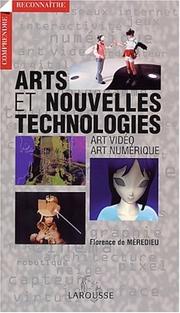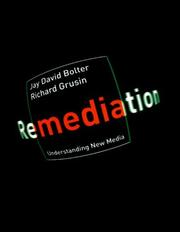| Listing 1 - 3 of 3 |
Sort by
|

ISBN: 2035051967 9782035051967 Year: 2003 Publisher: Paris Larousse
Abstract | Keywords | Export | Availability | Bookmark
 Loading...
Loading...Choose an application
- Reference Manager
- EndNote
- RefWorks (Direct export to RefWorks)
Art numérique --- Art video --- Digital art --- Digitale kunst --- Video art --- Videokunst --- Video art. --- Digital art. --- Art vidéo --- Electronic art --- Experimental television --- Art, Modern --- Performance art --- Television --- Experimental films --- Art, Computer --- Computer craft --- New media art --- Computer art --- Art par ordinateur --- Art électronique --- Vidéo expérimentale --- Vidéo formelle --- Vidéo-art --- Art vidéo

ISBN: 9780262522793 0262522799 0262024527 9780262024525 Year: 2000 Publisher: Cambridge (MA) ; London : M.I.T. Press,
Abstract | Keywords | Export | Availability | Bookmark
 Loading...
Loading...Choose an application
- Reference Manager
- EndNote
- RefWorks (Direct export to RefWorks)
Media critics remain captivated by the modernist myth of the new : they assume that digital technologies such as the World Wide Web, virtual reality, and computer graphics must divorce themselves from earlier media for a new set of aesthetic and cultural principles. In this richly illustrated study, Jay David Bolter and Richard Grusin offer a theory of mediation for our digital age that challenges this assumption.They argue that new visual media achieve their cultural significance precisely by paying homage to, rivaling, and refashioning such earlier media as perspective painting, photography, film, and television. They call this process of refashioning "remediation," and they note that earlier media have also refashioned one another : photography remediated painting, film remediated stage production and photography, and television remediated film, vaudeville, and radio.In chapters devoted to individual media or genres (such as computer games, digital photography, virtual reality, film, and television), Bolter and Grusin illustrate the process of remediation and its two principal styles or strategies : transparent immediacy and hypermediacy. Each of these strategies has a long and complicated history. A painting by the seventeenth-century artist Pieter Saenredam ; a photograph by Edward Weston, and a computer system for virtual reality are all attempts to achieve transparent immediacy by ignoring or denying the presence of the medium.A medieval illuminated manuscript, an early twentieth-century photomontage, and today's buttoned and windowed multimedia applications are instances of hypermediacy - a fascination with the medium itself. Although these two strategies appear contradictory, they are in fact the two necessary halves of remediation.
Digitale kunsten ; vrije en toegepaste ; theorie --- Nieuwe media ; theorie --- Communicatievormen; computercommunicatie; Internet --- Gebruiksgrafiek ; theorie, filosofie, esthetica --- Kunst ; theorie, filosofie, esthetica --- massamedia - publiciteitswezen - audiovisuele media; algemeen, audiovisuele media, algemeen --- Mass communications --- 766.01 --- 7.01 --- Communicating Knowledge --- 098 --- Mass media --- 33 --- 791.5 --- communicatie --- computergrafiek --- computers --- computerspellen --- cultuurfilosofie --- cyberspace --- digitale fotografie --- digitale kunst --- film --- fotografie --- informatietechnologie --- internet --- Jay David Bolter and Richard Grusin --- kunst --- kunst en technologie --- technologie --- televisie --- virtual reality --- virtuele realiteit --- 82:659.3 --- 82:7 --- 82:659.3 Literatuur en massacommunicatie --- Literatuur en massacommunicatie --- 82:7 Literatuur en kunst --- Literatuur en kunst --- Technological innovations --- Technological innovations. --- Médias --- Innovations --- Médias --- Virtual reality --- Computer graphics --- Société numérique --- Média --- Art numérique

ISBN: 9780262182621 0262182629 9780262321853 9780262028288 Year: 2014 Publisher: The MIT Press
Abstract | Keywords | Export | Availability | Bookmark
 Loading...
Loading...Choose an application
- Reference Manager
- EndNote
- RefWorks (Direct export to RefWorks)
The visual arts are rapidly changing as media moves into the web, mobile devices, and architecture. When designers and artists learn the basics of writing software, they develop a new form of literacy that enables them to create new media for the present, and to imagine future media that are beyond the capacities of current software tools. This book introduces this new literacy by teaching computer programming within the context of the visual arts. It offers a comprehensive reference and text for Processing (www.processing.org), an open-source programming language that can be used by students, artists, designers, architects, researchers, and anyone who wants to program images, animation, and interactivity. Written by Processing's cofounders, the book offers a definitive reference for students and professionals. Tutorial chapters make up the bulk of the book; advanced professional projects from such domains as animation, performance, and installation are discussed in interviews with their creators.This second edition has been thoroughly updated. It is the first book to offer in-depth coverage of Processing 2.0 and 3.0, and all examples have been updated for the new syntax. Every chapter has been revised, and new chapters introduce new ways to work with data and geometry. New “synthesis” chapters offer discussion and worked examples of such topics as sketching with code, modularity, and algorithms. New interviews have been added that cover a wider range of projects. “Extension” chapters are now offered online so they can be updated to keep pace with technological developments in such fields as computer vision and electronics.
Computer programming --- Computer graphics --- Computer art --- Art --- Art and technology --- Computer programs --- Data processing --- Art and technology. --- Computer programming. --- Digital art --- Data processing. --- Computer programs. --- Artificial intelligence. Robotics. Simulation. Graphics --- Programmation (Informatique) --- Infographie --- Art par ordinateur --- Art et technologie --- Logiciels --- Informatique --- Programmeren --- Digitale kunst --- Digitale beeldbewerking --- Digitale typografie --- Codeersystemen --- Grafische vormgeving --- Open source software --- Audiovisuele media --- Technology and art --- Technology --- Art, Occidental --- Art, Visual --- Art, Western (Western countries) --- Arts, Fine --- Arts, Visual --- Fine arts --- Iconography --- Occidental art --- Visual arts --- Western art (Western countries) --- Arts --- Aesthetics --- Art, Computer --- Computer craft --- New media art --- Computers --- Electronic computer programming --- Electronic data processing --- Electronic digital computers --- Programming (Electronic computers) --- Coding theory --- Programming --- software --- designs [artistic concepts] --- Codeersysteem --- Opensourcesoftware --- Kind --- Art, Primitive --- Computer graphics - Computer programs --- Computer art - Computer programs --- Art - Data processing
| Listing 1 - 3 of 3 |
Sort by
|

 Search
Search Feedback
Feedback About
About Help
Help News
News